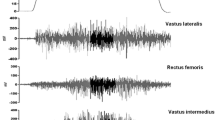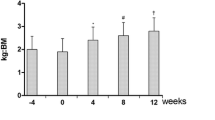Abstract
The aim of this study was to examine effects of 21-week twice weekly strength (ST), endurance (ET) and combined (ST + ET 2 + 2 times a week) (SET) training on neuromuscular, endurance and walking performances as well as balance. 108 healthy men (56.3 ± 9.9 years) were divided into three training (ST; n = 30, ET; n = 26, SET; n = 31) groups and controls (C n = 21). Dynamic 1RM and explosive leg presses (1RMleg, 50%1RMleg), peak oxygen uptake using a bicycle ergometer (VO2peak), 10 m loaded walking time (10WALK) and dynamic balance distance (DYND) were measured. Significant increases were observed in maximal 1RMleg of 21% in ST (p < 0.001) and 22% in SET (p < 0.001) and in explosive 50%1RMleg of 7.5% in ST (p = 0.005) and 10.2% in SET (p < 0.001). VO2peak increased by 12.5% in ET (p = 0.001) and 9.8% in SET (p < 0.001). Significant decreases occurred in 10WALK in ST (p < 0.001) and SET (p = 0.003) and also in DYND of −10.3% in ST (p = 0.002) and −8% in SET (p = 0.028). The changes in C remained minor in all variables. In conclusion, ST and SET training produced significant improvements in maximal and explosive strength, walking speed and balance without any interference effect in SET. Significant but moderate relationships were observed between strength and dynamic balance and walking speed, while no corresponding correlations were found in the ET group.






Similar content being viewed by others
References
American College of Sports Medicine (2000) ACSM’s guidelines for exercise testing and prescription. Senior editor Franklin BA. (6th ed.). Lippincott Williams & Wilkins, Philadelphia 50
American College of Sports Medicine position stand Chodzko-Zaiko WJ, Proctor DN, Fiatarone Singh MA, Minson CT, Nigg CR, Salem GJ, Skinner JS (2009) Exercise and physical activity for older adults. Med Sci Sports Exerc 41(7):1510–1530
Aunola S, Rusko H (1984) Reproducibility of aerobic and anaerobic thresholds in 20–50 year old men. Eur J Appl Occup Physiol 53(3):260–266
Astrand I, Astrand PO, Hallback I, Kilbom A (1973) Reduction in maximal oxygen uptake with age. J Appl Physiol 35:649–654
Baker MK, Atlantis E, Fiatarone Singh MA (2007) Multi-modal exercise programs for older adults. Age and Ageing 36:375–381
Bell GJ, Syrotuik D, Martin TP, Burnham R, Quinney HA (2000) Effect of concurrent strength and endurance training on skeletal muscle properties and hormone concentrations. Eur J Appl Physiol 81:418–427
Bellew J, Yates J, Gater D (2003) The initial effects of low volume strength training on balance in untrained older men and women. J Strength Condition Res 17:121–128
Bohannon RW (1997) Comfortable and maximum walking speed of adults aged 20–79 years: reference values and determinants. Age Ageing 26:15–19
Buchner DM, Cress ME, De Lateur BJ (1997) The effect of strength and endurance training on gait, balance, fall risk, and health service use in community-living older adults. J Gerontol Med Sci 52A:M218–M224
Chtara M, Chamari K, Chaouachi M, Chaouachi A, Koubaa D, Feki Y, Millet GP, Amri M (2005) Effects of intra-session concurrent endurance and strength training sequence on aerobic performance and capacity. Br J Sports Med 39:555–560
Dudley GA, Djamilj R (1985) Incompatibility of endurance- and strength-training modes of exercise. J Appl Physiol 59:1446–1451
Era P, Sainio P, Koskinen S, Haavisto P, Vaara M, Aromaa A (2006) Postural balance in a random sample of 7, 979 subjects aged 30 years and over. Gerontology 52(4):204–213
Fiatarone MA, Marks EC, Ryan ND, Meredith CN, Lipsitz LA, Evans WJ (1990) High-intensity strength training in nonagenarians. J Am Med Assoc 263:3029–3034
Faulkner JA, Larkin LM, Claffin DR, Brooks SV (2007) Age-related changes in the structure and function of skeletal muscles. Clin Exp Pharmacol Physiol 34:1091–1096
Fleg JL, Morrell CH, Bos AG, Brant LJ, Talbot LA, Wright JG, Lakatta EG (2005) Accelerated longitudinal decline of aerobic capacity in healthy older adults. Circulation 112:674–682
Frontera WR, Meredith CN, O’Reilly KP, Knuttgen HG, Evans WJ (1988) Strength conditioning in older men: skeletal muscle hypertrophy and improved function. J Appl Physiol 64:1038–1044
Hickson R (1980) Interference of strength development by simultaneously training for strength and endurance. Eur J Appl Physiol 45:255–263
Hollenberg M, Yang J, Haight TJ, Tager IB (2006) Longitudinal changes in aerobic capacity: implications for concepts of aging. J Gerontol A Biol Med Sci 61:851–858
Holviala J, Häkkinen A, Karavirta L, Nyman K, Izquierdo M, Gorostiaga EM, Avela J, Korhonen J, Knuutila VP, Kraemer WJ, Häkkinen K (2010) Effects of combined strength and endurance training on treadmill load carrying walking performance in aging men. J Strength Condition Res 24(6):1584–1595
Holviala J, Salinen J, Kraemer WJ, Alen M, Häkkinen K (2006) Effects of strength training on muscle strength characteristics, functional capabilities, and balance in middle-aged and older women. J Strength Condition Res 20(2):336–344
Horak FB (2006) Mechanistic and physiological aspects postural orientation and equilibrium: what do we need to know about neural control of balance to prevent falls. Age Ageing 35(S2):7–11
Häkkinen K (1994) Neuromuscular adaptation during strength training, aging, detraining and immobilization: a review. Crit Rev Phys Rehabil Med 6(2):161–198
Häkkinen K, Alen M, Kraemer WJ, Gorostiaga E, Izquierdo M, Rusko H, Mikkola J, Häkkinen A, Valkeinen H, Kaarakainen T, Romu S, Erola V, Ahtiainen J, Paavolainen L (2003) Neuromuscular adaptations during concurrent strength and endurance training versus strength training. Eur J Appl Physiol 89:42–52
Häkkinen K, Kallinen M, Izquierdo M, Jokelainen K, Lassila H, Mälkiä E, Kramer WJ, Newton RU, Alen M (1998) Changes in agonist-antagonist EMG, muscle CSA, and force during strength training in middle-aged and older people. J Appl Physiol 84(4):1341–1349
Häkkinen K, Kraemer WJ, Newton RU, Alen M (2001) Changes in electromyographic activity, muscle fiber and force production characteristics during heavy resistance/power strength training in middle-aged and older men and women. Acta Physiol Scand 171(1):51–62
Ilmarinen J (1992) Job design for the aged with regard to decline in their maximal capacity: Part I–Guidelines for the practioner. Int J Ind Ergon 10:53–65
Izquierdo M, Häkkinen K, Ibañez J, Kraemer WJ, Gorostiaga EM (2005) Effects of combined resistance and cardiovascular training on strength, power, muscle cross-sectional area and endurance markes in middle-aged men. Eur J Appl Physiol 94(1–2):70–75
Jiménez-Jiménez FE, Calleja M, Alonso-Navarro H, Rubio L, Navacerreda F, Pilo-de-la-Fuente B, Plaza-Nieto JF, Arroyo-Solera M, Garcia-Ruiz PJ, Garcia-Martin E, Agundez JAG (2011) Influence of age and gender in motor performance in healthy subjects. J Neurol Sci 302:72–80
Jozsi A, Campbell W, Joseph L, Davey S, Evans W (1999) Changes in power with resistance training in older and younger men and women. J Gerontol A Biol Med Sci: Nov 54(11):M591–M596
Karavirta L, Tulppo MP, Laaksonen DE, Nyman K, Laukkanen RT, Kinnunen H, Häkkinen A, Häkkinen K (2009) Heart rate dynamics after combined endurance and strength training in older men. Med Sci Sports Exerc 41(7):1436–1443
Kasch FW, Boyer JL, Van Camp S, Nettl F, Verity LS, Wallace JP (1995) Cardiovascular changes with age and exercise: a 28-year longitudinal study. Scand J Med Sci Sports 5:147–151
Kraemer WJ, Marchitelli L, Gordon SE, Harman E, Dziados JE, Mello R, Frykman P, McCurry D, Fleck SJ (1990) Hormonal and growth factor responses to heavy resistance exercise protocols. J Appl Physiol 69(4):1442–1450
Kraemer WJ, Patton JF, Gordon SE (1995) Compatibility of high-intensity strength and endurance training on hormonal and skeletal muscle adaptations. J Appl Physiol 78:976–989
Landers K, Hunter G, Wetztein C, Bamman M, Weinsteir R (2001) The interrelationship among muscle mass, strength and the ability to perform physical tasks of daily living in younger and older women. J Gerontol Ser A Biol Sci Med Sci 56A(10):B443–B448
Lord SR (2006) Visual risk factors for falls in older people. Age Ageing 35(S2):42–45
Lord SR, Menz HB, Tiedmann A (2003) A physiological profile approach to fall risk assessment and prevention. Phys Therapy 83(3):238–239
Matheson AJ, Darlington CL, Smith PF (1999) Dizziness in the elderly and age-related degeneration of the vestibular system. NZJ Psychol 28(1):10–16
Mian OS, Baltzopoulos V, Minetti AE, Narici MV (2007) The impact of physical training on locomotor function in older people. Sports Med 37(8):683–701
Moritani T, Devries HA (1980) Potential for gross muscle hypertrophy in older men. J Gerontol 35:672–682
Orr R, Raymond J, Fiatarone Singh MA (2008) Efficacy of progressive resistance training on balance performance in older adults: a systematic review of randomized controlled trials. Sports Med 38(4):317–343
Rantanen T (2003) Muscle strength, disability and mortality. Scand J Med Sci Sports 13:3–8
Runge M, Hunter G (2006) Determinants of musculoskeletal frailty and the risk of falls in old age. J Musculoskelet Neuron Interact 6(2):167–173
Ryall JG, Schertzer JD, Lynch GS (2008) Cellular and molecular mechanisms underlying age-related skeletal muscle wasting and weakness. Biogerontology 9:213–228
Seniam European Recommendations for Surface ElectroMyoGraphy (2004) Biomedical and Health Research Program. Roessingh Research and Development b.v
Schrack JA, Simonsick EM, Ferrucci L (2010) The energetic pathway to mobility loss: an emerging new framework for longitudinal studies on aging. J Am Geriatr Soc 58(Suppl 2):S329–S336
Sillanpää E, Laaksonen DE, Häkkinen A, Karavirta L, Jensen B, Kraemer WJ, Nyman K, Häkkinen K (2009) Body composition, fitness and metabolic health during strength and endurance training and their combination in middle aged and older women. Eur J Appl Physiol 106(2):285–296
Sipilä S, Multanen J, Kalinen M, Era P, Suominen H (1996) Effects of strength and endurance training on isometric muscle strength and walking speed in eldery women. Acta Physiol Scand 156(4):457–464
Stathokostas L, Jacob-Johnson S, Petrella RJ, Paterson DH (2004) Longitudinal changes in aerobic power in older men and women. J Appl Physiol 97:781–789
Valkeinen H, Alen M, Häkkinen A, Hannonen P, Kukkonen-Harjula K, Häkkinen K (2008) Effects of concurrent strength and endurance training on physical fitness and symptoms in postmenopausal women with fibromyalgia: a randomized controlled trial. Arch Physical Med Rehabil 89(9):1660–1666
Whipple R, Wolfson L, Derby C, Singh D, Tobin J (1993) 10 altered sensory function and balance in older persons. J Gerontol48:71–76
Wolfson L, Whipple R, Derby C (1996) Balance and strength training in older adults: intervention gains and tai chi maintenance. J Am Geriatr Soc 44:498–506
Wood RH, Reyes R, Welsch MA, Favaloro-Sabatier J, Sabatier M, Lee CM, Johnson LG, Hooper PF (2001) Concurrent cardiovascular and resistance training in healthy older adults. Med Sci Sports Exerc 33(10):1751–1758
Author information
Authors and Affiliations
Corresponding author
Additional information
Communicated by Fausto Baldissera.
Rights and permissions
About this article
Cite this article
Holviala, J., Kraemer, W.J., Sillanpää, E. et al. Effects of strength, endurance and combined training on muscle strength, walking speed and dynamic balance in aging men. Eur J Appl Physiol 112, 1335–1347 (2012). https://doi.org/10.1007/s00421-011-2089-7
Received:
Accepted:
Published:
Issue Date:
DOI: https://doi.org/10.1007/s00421-011-2089-7




